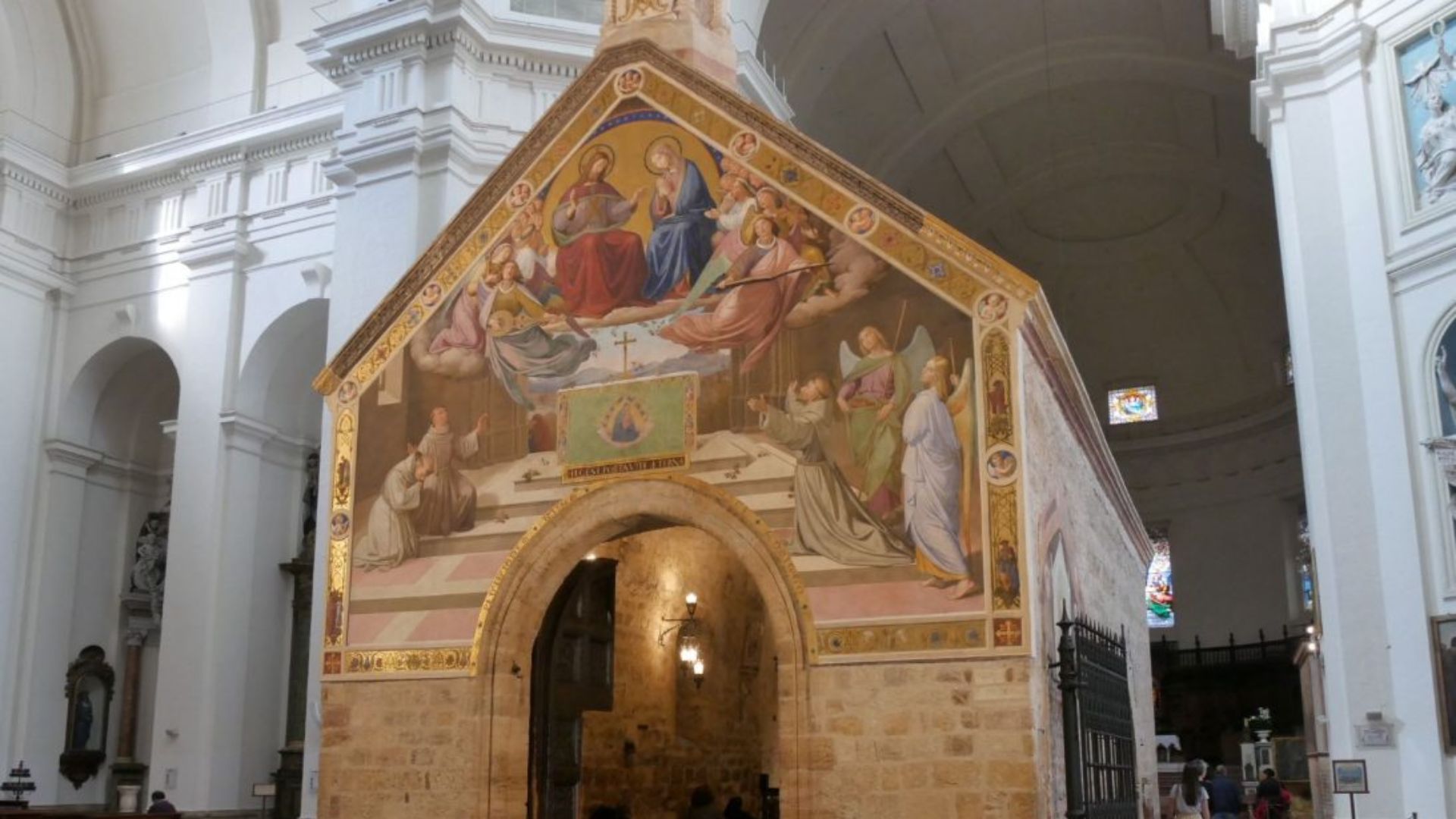Nearly 250 years ago, during a Spanish expedition in Alta California led by Gaspar de Portola, a beautiful river captured the imagination of Father Juan Crespi, a Franciscan missionary priest in the traveling party. Struck by its serenity, he decided to name it after a little chapel located 6,700 miles away.
It was August 2, 1769, the feast of Our Lady of the Angels of the Porciuncula, also known as "Portiuncula," meaning "a little part." This chapel held special significance as it was associated with St. Francis of Assisi, the founder of the Franciscans.
Twelve years later, on September 14, 1781, a town was established near the river by a small group of 44 settlers from Mexico, known as El Pueblo de Nuestra Senora de Los Angeles de la Porciuncula.
Today, this city, now called Los Angeles, is home to a grand cathedral bearing the name of Our Lady of the Angels, which house the small Porciuncula Church of St. Francis of Assisi, renovated by the Saint some 800 years ago .

The chapel, though small at just 18 feet by 10 feet, continues to draw thousands of visitors each year. Many are pilgrims inspired by St. Francis' example, and all are captivated by the presence of a tiny chapel within a larger basilica.
The Papal Basilica of Santa Maria degli Angeli (St. Mary of the Angels) houses the Porciuncula chapel. Located two miles from the Papal Basilica of St. Francis of Assisi, where the saint is buried, the church sits at the base of the hill town of Assisi and is equidistant from Florence and Rome.
Tradition has it that the Porciuncula chapel's origins can be traced back to the fourth century, but it fell into disrepair over time.
St. Francis, following a pilgrimage to Rome, experienced a mystical vision of Jesus Christ in the dilapidated chapel of San Damiano. In this vision, the crucified Christ icon came to life and implored St. Francis three times to "go and repair my house which, as you can see, is falling into ruins."
To St. Francis, this meant not only restoring the chapel he was praying in but also undertaking the rebuilding of other poorly maintained churches. The Porciuncula chapel held special significance for him, as it was here that he founded the Order of Friars Minor (the Franciscans) and received Clare of Assisi, founding the Second Order of the Poor Ladies (Poor Clares). Until his death in 1226, the little chapel remained a primary source of inspiration for St. Francis.

The Papal Basilica of St. Francis of Assisi housing the bruial crypt of St Francis, is the mother church of the Order of Friars Minor, a UNESCO World Heritage Site since 2000.
Throughout the centuries, St. Francis' followers diligently maintained the Porciuncula Church as a holy site for pilgrims. In the 16th century, St. Pope Pius V initiated the construction of Santa Maria degli Angeli to preserve the cherished chapel. This process began in 1569, two centuries before the Portola expedition in California, and took 110 years to complete.
Over time, the Porciuncula chapel has been adorned with artwork from various periods, including an 1829 fresco by Johann Overbeck portraying St. Francis receiving the "Pardon of Assisi" from Jesus and Mary. Inside, a six-part fresco, painted by Father Ilano da Viterbo in 1393, depicts significant events such as the Annunciation and an apparition of Christ and the Virgin, with St. Francis offering roses. The Porciuncula remains a cherished symbol of St. Francis' enduring legacy, drawing people from all corners of the world to pay homage to the humble origins of the Franciscan Order.
St. Francis, inspired by his deep spiritual experiences at the Portiuncula, fervently prayed for a special blessing to be bestowed upon all those who visited this sacred place. His heartfelt request reached the ears of Pope Honorius III, who recognized the profound devotion of the humble friar. In response to St. Francis' plea, the Pope granted plenary indulgence for all those who would make a pilgrimage to the Portiuncula.
The plenary indulgence was initially limited to a specific time: from noon on August 1st to midnight on August 2nd each year. However, as time went on, the significance of this blessing spread far and wide. It wasn't just confined to the chapel's sacred grounds; the privilege extended to any church where Franciscan Friars lived and ministered.
Over the centuries, the little chapel became a beacon of hope, a place where the burdens of sin were lifted, and hearts were filled with renewed faith and love for God.
The plenary indulgence can now be gained in any basilica, cathedral, or parish church on August 2. The person wishing to gain the Indulgence must fulfill the following requirements:
a. Intend to gain the Indulgence
b. Be detached from all sin
c. While in the church pray one Our Father, one Apostle's Creed, and one other prayer of the individual's choice
d. Pray for the intentions of the Pope (prayerfully saying an Our Father and a Hail Mary will suffice although other prayers may be said)
e. Receive the Sacraments of Reconciliation and Eucharist within one week either before or after August 2.
The little chapel, filled with God's grace, remains a sacred space where pilgrims find comfort, forgiveness, and the eternal hope of redemption.